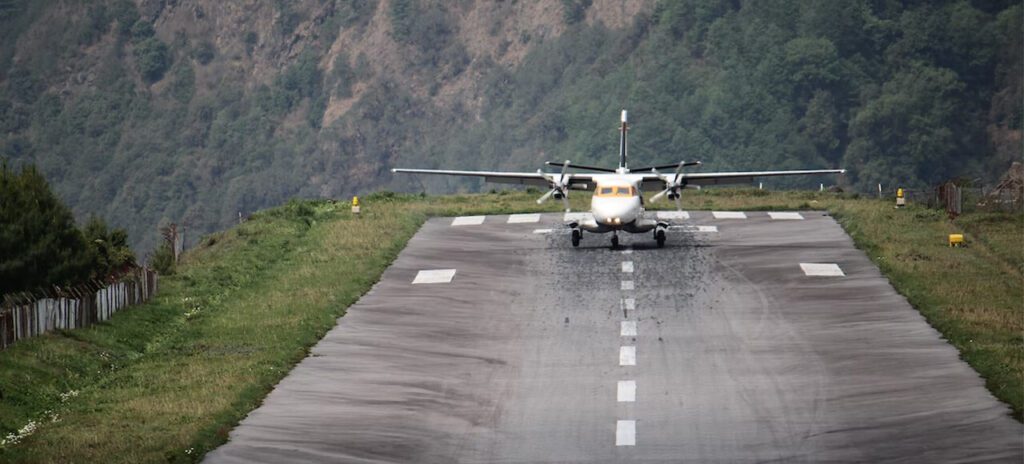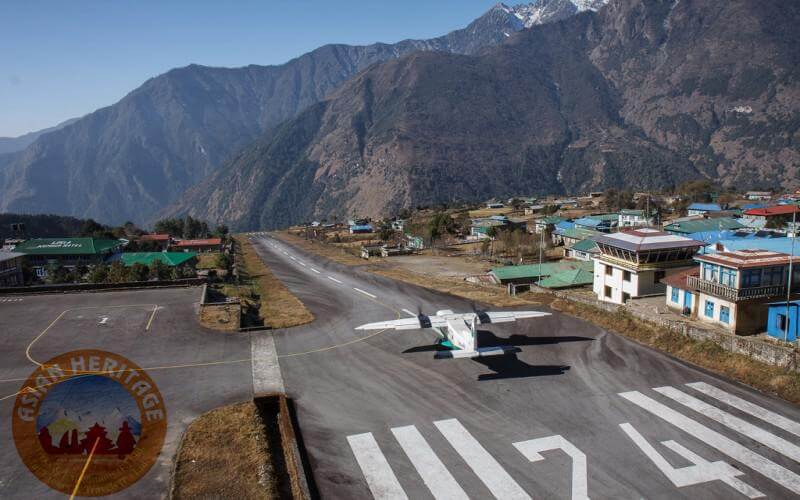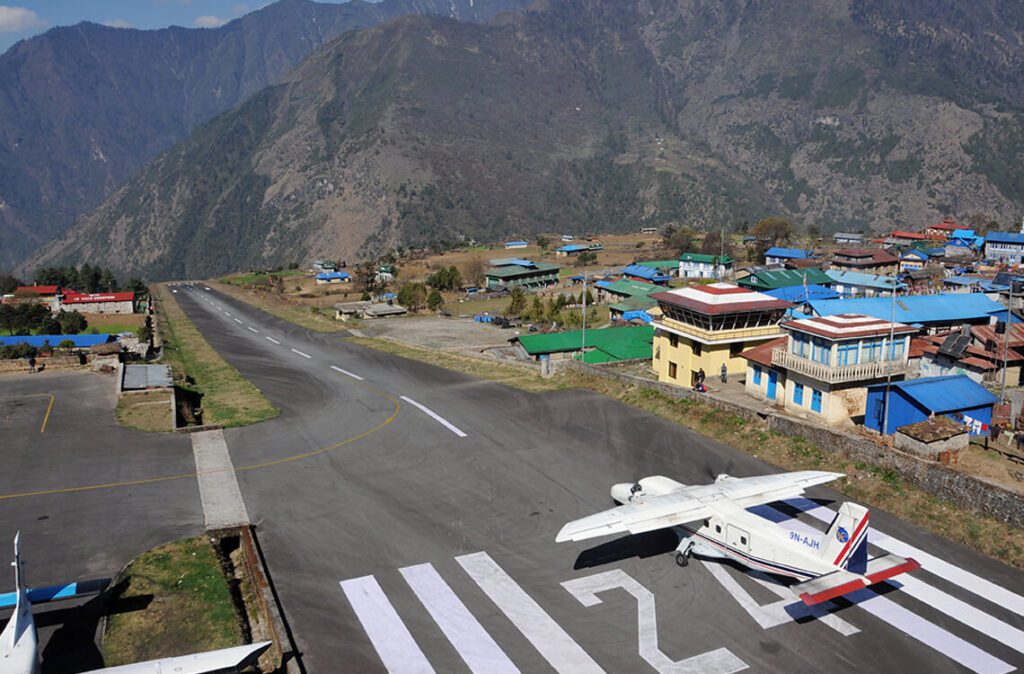Perched on the edge of a cliff, Lukla Airport in Nepal has gained a notorious reputation as one of the most dangerous airports in the world. With its hair-raising runway and unpredictable weather conditions, Lukla Airport challenges the nerves of even the most seasoned travelers. But for those with an appetite for adventure, it offers an unforgettable experience that will leave you with tales to tell for a lifetime.

Known as one of the most dangerous and thrilling airports in the world, Lukla Airport serves as the gateway to the Everest Region, attracting countless trekkers and mountaineers eager to conquer the highest peak on Earth, Mount Everest.
In this blog post, we will take a closer look into the captivating history, unique features, and remarkable challenges of Lukla Airpor while exploring why it continues to captivate the hearts of adventurers and thrill-seekers alike.
A Brief History of Lukla Airport
Lukla Airport, officially named Tenzing-Hillary Airport, was constructed in 1964 as an airstrip to facilitate transportation for Sir Edmund Hillary’s Himalayan Trust. Named in honor of Sir Edmund Hillary and Tenzing Norgay, the first climbers to summit Mount Everest, the airport became a vital link between Kathmandu and the remote Solu-Khumbu region.
Also Read: 7 Best Trekking Destinations In Nepal For 2023
Over time, Lukla Airport gained recognition as the starting point for the iconic Everest Base Camp Trek, cementing its position as an essential hub for mountaineering expeditions.
Geographic Location and Unique Features
Situated at an altitude of 2,846 meters, Lukla Airport is perched on a steep mountainside, surrounded by towering peaks. The airport features a single asphalt runway that is only 527 meters (1,729 feet) long, making it one of the shortest commercial runways in the world.

Its challenging topography and unpredictable weather conditions pose a formidable test for even the most experienced pilots. The breathtaking views of the Himalayas that greet passengers as they approach and depart Lukla Airport are a remarkable testament to the beauty and grandeur of the region.
The Thrill of the Lukla Airport Experience
The thrill and adventure associated with Lukla Airport cannot be understated. With limited space for maneuvering, pilots must navigate a steep descent during the approach and a perilous uphill takeoff when departing. The short runway, coupled with the ever-changing mountain weather, adds an extra layer of complexity to each flight.
Trekking enthusiasts embarking on their journey to Everest Base Camp often find the landing and takeoff experiences at Lukla Airport both nerve-wracking and exhilarating, setting the tone for the adventure that lies ahead.
Beyond the Lukla Airport: Exploring the Everest Region
Lukla Airport serves as the gateway to an array of breathtaking treks and mountaineering expeditions. Beyond the thrill of the airport itself, trekkers can embark on the iconic Everest Base Camp Trek, which takes them through picturesque Sherpa villages, breathtaking valleys, and awe-inspiring glaciers.

Other popular treks in the region include the Gokyo Lakes Trek and the Three Passes Trek. These treks offer unparalleled views of the Everest massif and allow adventurers to immerse themselves in the rich Sherpa culture.
Lukla Airport Runaway length and Limitations
The short runway length at Lukla Airport presents certain limitations and considerations. The relatively small size of the runway restricts the type and size of aircraft that can operate at the airport. Typically, only small aircraft, such as Twin Otters or Dornier Do 228s, are used for flights to and from Lukla.

The limited runway length also affects the weight capacity of the aircraft, requiring careful calculations to ensure safe takeoffs and landings. These limitations highlight the importance of precise flight planning and skilled piloting, making Lukla a unique and challenging destination for aviation enthusiasts.
Lukla Airport Code
The aviation community uses the IATA code “LUA” and the ICAO code “VNLK” to identify and reference Lukla Airport. The IATA code, “LUA,” derives from the name Lukla, while the ICAO code, “VNLK,” reflects the airport’s location in Nepal.
You may also like: 19 You Need To Know Before Visiting Nepal
It is important to note that the Lukla Airport code, especially the IATA code, may not be as widely recognized as larger international airports. Due to its remote location and limited commercial air traffic, Lukla primarily serves as a regional airport catering to trekkers, mountaineers, and local communities in the Everest Region.
Safety Measures and Incidents
Lukla Airport has made significant improvements in terms of safety measures over the years. The introduction of paved runways, navigational aids, and enhanced airport guidelines has contributed to safer operations. These measures aim to mitigate the risks associated with the airport’s challenging topography and unpredictable weather conditions.

However, it is worth mentioning that, like any airport, Lukla has experienced incidents in the past. The unique terrain and weather conditions pose inherent risks that pilots and passengers must be aware of. While there have been unfortunate instances of accidents or incidents, it is essential to recognize that they are relatively rare, considering the thousands of flights that operate safely to and from Lukla each year.
Weather Conditions and Challenges
Lukla Airport’s location in the heart of the Himalayas exposes it to ever-changing and often harsh weather conditions. The region experiences a mix of microclimates due to its complex mountainous terrain, making weather forecasting a challenging task. The airport is particularly susceptible to rapid weather changes, including fog, strong winds, and sudden cloud formations.

The unpredictable weather poses significant challenges for flight operations at Lukla Airport. Poor visibility and strong crosswinds can make landing and takeoff extremely difficult and risky. To ensure the safety of passengers and crew, airlines may delay or cancel flights at short notice.
Risk Assessment and Mitigation
This airport presents inherent risks due to its challenging topography, short runway, and unpredictable weather conditions. Both aviation professionals and travelers need to understand and assess these risks to ensure safe operations. Risk assessment is a crucial aspect of operating at Lukla. Pilots undergo rigorous training and acquire specialized skills to handle the unique challenges presented by the airport.
Related: Muktinath: A Sacred Temple In The Himalayas
They carefully evaluate factors such as weather conditions, runway length, aircraft performance, and weight limitations before attempting a landing or takeoff. This risk assessment process helps to mitigate potential dangers and ensures the safety of all onboard.
Need Help Planning an exciting trip?
Let our expert team at Asian Heritage Treks and Travel take care of everything — from guided tours to personalized packing tips and travel arrangements.
Plan an exciting trip






